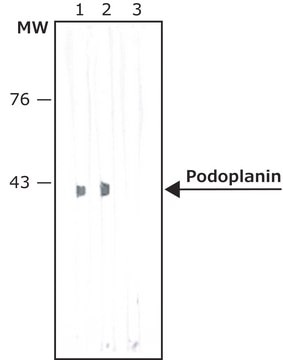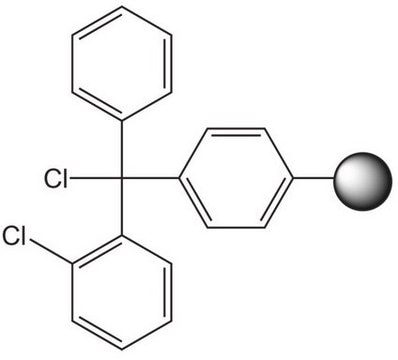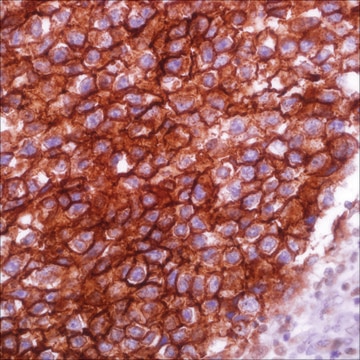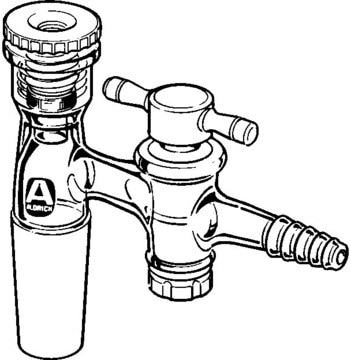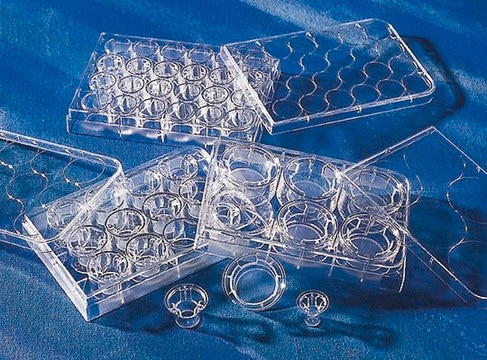General description
Podoplanin (UniProt: Q86YL7; also known as Aggrus, Glycoprotein 36, Gp36, PA2.26 antigen, T1-alpha, T1A) is encoded by the PDPN (also known as GP36) gene (Gene ID: 10630) in human. Podoplanin serves as the endogenous ligand of C-type lectin-like receptor-2 (CLEC-2) and is highly expressed in various tumors and in some normal cells, such as lymphatic endothelial cells and podocytes. A high degree of expression is observed in placenta, lung, skeletal muscle, and brain. It may be involved in cell migration and/or actin cytoskeleton organization. Podoplanin is localized to actin-rich microvilli and plasma membrane projections, such as filopodia, lamellipodia, and ruffles. Six isoforms of podoplanin have been described that are produced by alternative splicing. It is synthesized with a signal peptide of 22 amino acids, which is cleaved to produce the mature form. Podoplanin contains an extracellular domain (aa 23-131), a helical domain (aa 132-152) and a cytoplasmic region (aa 153-162). Podoplanin possesses three tandem repeat of platelet aggregation-stimulating (PLAG) domains in its N-terminus. Among the PLAG domains, sialylated O-glycan on Thr52 of PLAG3 is essential for the binding to C-type lectin-like receptor-2 (CLEC-2). Interaction of human podoplanin with CLEC-2 mainly involves Glu47 and Asp48 in the platelet PLAG3. For clone LpMab-21 a minimum epitope is determined to be Thr76-Arg79 of the human podoplanin with sialic acid linked to Thr76. LpMab-21 39 detects human podoplanin expression in glioblastoma, oral squamous carcinoma, and seminoma 40 cells as well as in normal lymphatic endothelial cells. However, it does not react with renal glomerular epithelial cells or lung type I alveolar cells, indicating that sialylation of human podoplanin Thr76 is cell-type specific. (Ref.: Kato, Y et al (2017). Monoclon Antib Immunodiagn Immunother. 36(1); 20-24; Kaneko, MK et al. (2017). Cancer Med.; 6(2):382-396).
Specificity
Clone LpMab-21 detects human podoplanin. It targets a minimum epitope Thr76-Arg79 witih sialic acid linked to Thr76.
Immunogen
LN229 glioma cells transfected with human podoplanin.
Application
Anti-Podoplanin, clone LpMab-21, Cat. No. MABT852, is a mouse monoclonal antibody that detects human Podoplanin and has been tested for use in ELISA, Flow Cytometry, and Immunohistochemistry (Paraffin).
Immunohistochemistry Analysis: A representative lot detected Podoplanin in Immunohistochemistry applications (Kaneko, M.K., et. al. (2017). Cancer Med. 6(2):382-396).
ELISA Analysis: A representative lot detected Podoplanin in ELISA applications (Kaneko, M.K., et. al. (2017). Cancer Med. 6(2):382-396).
Flow Cytometry Analysis: A representative lot detected Podoplanin in Flow Cytometry applications (Kaneko, M.K., et. al. (2017). Cancer Med. 6(2):382-396).
Research Category
Cell Structure
Quality
Evaluated by Flow Cytometry in HEK293 cells.
Flow Cytometry Analysis: 1 µg of this antibody detected Podoplanin in one million HEK293 cells.
Target description
16.70 kDa calculated.
Physical form
Format: Purified
Protein G purified
Purified mouse monoclonal antibody IgG2a in buffer containing 0.1 M Tris-Glycine (pH 7.4), 150 mM NaCl with 0.05% sodium azide.
Storage and Stability
Stable for 1 year at 2-8°C from date of receipt.
Other Notes
Concentration: Please refer to lot specific datasheet.
Disclaimer
Unless otherwise stated in our catalog or other company documentation accompanying the product(s), our products are intended for research use only and are not to be used for any other purpose, which includes but is not limited to, unauthorized commercial uses, in vitro diagnostic uses, ex vivo or in vivo therapeutic uses or any type of consumption or application to humans or animals.
![RuCl(p-cymene)[(R,R)-Ts-DPEN]](/deepweb/assets/sigmaaldrich/product/structures/161/670/212e6eb8-dce1-4397-a5ef-3e2e3a296e8c/640/212e6eb8-dce1-4397-a5ef-3e2e3a296e8c.png)
